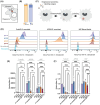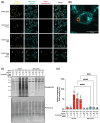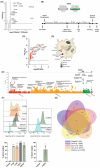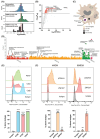This is a preprint.
Proximity labeling defines the phagosome lumen proteome of murine and primary human macrophages
- PMID: 39282337
- PMCID: PMC11398489
- DOI: 10.1101/2024.09.04.611277
Proximity labeling defines the phagosome lumen proteome of murine and primary human macrophages
Abstract
Proteomic analyses of the phagosome has significantly improved our understanding of the proteins which contribute to critical phagosome functions such as apoptotic cell clearance and microbial killing. However, previous methods of isolating phagosomes for proteomic analysis have relied on cell fractionation with some intrinsic limitations. Here, we present an alternative and modular proximity-labeling based strategy for mass spectrometry proteomic analysis of the phagosome lumen, termed PhagoID. We optimize proximity labeling in the phagosome and apply PhagoID to immortalized murine macrophages as well as primary human macrophages. Analysis of proteins detected by PhagoID in murine macrophages demonstrate that PhagoID corroborates previous proteomic studies, but also nominates novel proteins with unexpected residence at the phagosome for further study. A direct comparison between the proteins detected by PhagoID between mouse and human macrophages further reveals that human macrophage phagosomes have an increased abundance of proteins involved in the oxidative burst and antigen presentation. Our study develops and benchmarks a new approach to measure the protein composition of the phagosome and validates a subset of these findings, ultimately using PhagoID to grant further insight into the core constituent proteins and species differences at the phagosome lumen.
Figures




Similar articles
-
The phagosome proteome: insight into phagosome functions.J Cell Biol. 2001 Jan 8;152(1):165-80. doi: 10.1083/jcb.152.1.165. J Cell Biol. 2001. PMID: 11149929 Free PMC article.
-
The Mycobacterium bovis bacille Calmette-Guerin phagosome proteome.Mol Cell Proteomics. 2010 Jan;9(1):32-53. doi: 10.1074/mcp.M900396-MCP200. Epub 2009 Oct 7. Mol Cell Proteomics. 2010. PMID: 19815536 Free PMC article.
-
Proteomic analysis of the Ehrlichia chaffeensis phagosome in cultured DH82 cells.PLoS One. 2014 Feb 18;9(2):e88461. doi: 10.1371/journal.pone.0088461. eCollection 2014. PLoS One. 2014. PMID: 24558391 Free PMC article.
-
Mycobacterium tuberculosis-specific phagosome proteome and underlying signaling pathways.J Proteome Res. 2012 May 4;11(5):2635-43. doi: 10.1021/pr300125t. Epub 2012 Apr 2. J Proteome Res. 2012. PMID: 22443300 Review.
-
Phagosome maturation and modulation of macrophage effector function by intracellular pathogens: target for therapeutics.Future Microbiol. 2022 Jan;17:59-76. doi: 10.2217/fmb-2021-0101. Epub 2021 Dec 8. Future Microbiol. 2022. PMID: 34877879 Review.
References
-
- Flannagan R. S., Jaumouillé V. & Grinstein S. The Cell Biology of Phagocytosis. Annu. Rev. Pathol. Mech. Dis. 7, 61–98 (2012). - PubMed
-
- Jordao L., Bleck C. K. E., Mayorga L., Griffiths G. & Anes E. On the killing of mycobacteria by macrophages. Cell. Microbiol. 10, 529–548 (2008). - PubMed
-
- Pittet M. J., Michielin O. & Migliorini D. Clinical relevance of tumour-associated macrophages. Nat. Rev. Clin. Oncol. 19, 402–421 (2022). - PubMed
-
- Vitale I., Manic G., Coussens L. M., Kroemer G. & Galluzzi L. Macrophages and Metabolism in the Tumor Microenvironment. Cell Metab. 30, 36–50 (2019). - PubMed
-
- Gabandé-Rodríguez E., Keane L. & Capasso M. Microglial phagocytosis in aging and Alzheimer’s disease. J. Neurosci. Res. 98, 284–298 (2020). - PubMed
Publication types
Grants and funding
LinkOut - more resources
Full Text Sources
